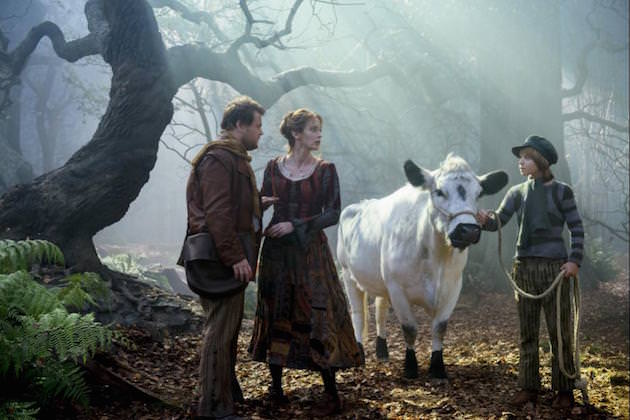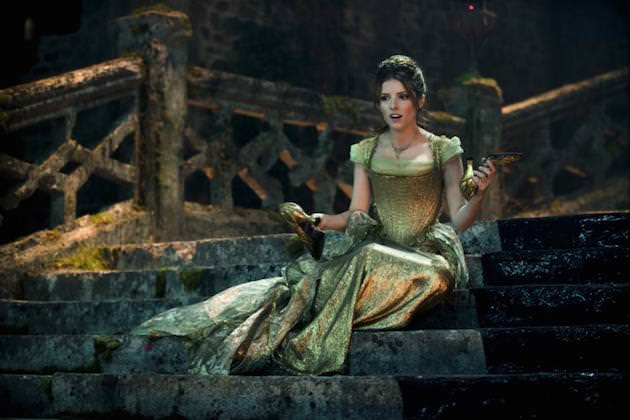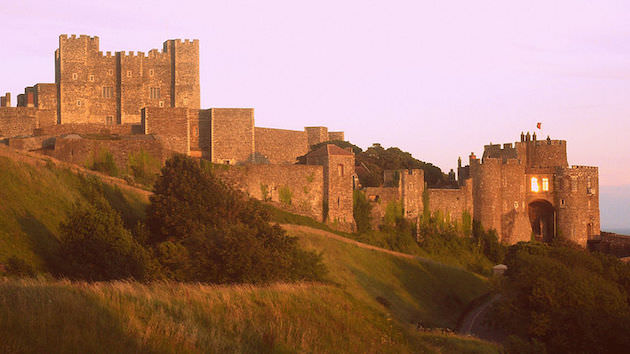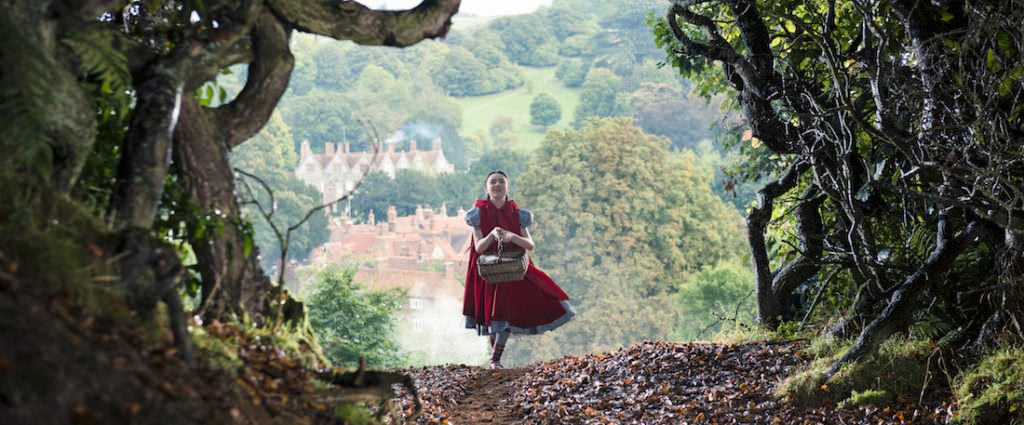Cinematographer Dion Beebe Takes us Into the Woods
Academy Award winning cinematographer Dion Beebe is now on his fourth film with Rob Marshall. He won an Oscar for his work on Marshall’s Memoirs of a Geisha in 2005. He was nominated for lensing Marshall’s Chicago in 2002. He was nominated for an ASC Award (American Society of Cinematographers) for another Marshall film, Nine, in 2009. And for their fourth collaboration, Into the Woods, Beebee has helped translate Stephen Sondheim and James Lapine’s Broadway musical into a lush, gorgeously shot film.
Into the Woods follows the stories of several fairytale characters as their fates are intertwined with the original story of a baker and his wife (James Corden and Emily Blunt). Sondheim and Lapine thrust Cinderella (Anna Kendrick), Little Red Riding Hood (Lilla Crawford), Jack (from the Beanstalk, played by Daniel Huttlestone), and Rapunzel (MacKenzie Mauzy) into an ordeal involving a curse put on the baker and his wife by a witch (Meryl Streep). There’s also the big bad wolf lurking about this narrative (in the form of Johnny Depp), and a hell of a lot of great singing and dancing.
Beebee is an expert at filming large, perfectly time choreographed numbers thanks to his work with Marshall in the past on films like Chicago and Nine. Yet he's hardly just Marshall’s cinematographer of choice; check out Michael Mann's Collateral from 2004, which Beebe shot, and, is worth watching for the shot of the coyote crossing the downtown L.A. street at night alone (the film itself is pretty great). He also lensed the fantastic Edge of Tomorrow, which had a conceit (a man keeps waking up after he's killed in battle only to have to do it all over again) which created a high degree of difficulty for everyone involved, especially the man tasked with keeping the continuity of the recurring battle the same.
Here's Beebe on matching his camera to the building of a big, Broadway-style song, the importance of rehearsal, the difficulty of shooting a film in which Tom Cruise keeps dying and more.
Before we discuss Into the Woods, I’d love to ask you about Edge of Tomorrow.
That was sort of a fun, big, complex movie to make. A lot of fun, actually. What Doug Liman brings to that process is a wonderful sense of playfulness to the big budget experience.
For a big budget sci-fi alien apocalypse movie, it was really funny, fun, and grimy. It looked more like a war film than anything else, really.
We made the decision very early on to shoot film, and I think even though it was a movie we knew was going to have a lot of CGI elements, because of the aliens, as soon as you have the aliens in our world, I think our reference for that film was the World War II/D-Day reference for that final assault on the beach.
A scene we keep revisiting thanks to the film’s central conceit of a guy who keeps waking up after he’s killed in the same place, having to go through the battle all over again.
Yeah, that was our pivotal action set piece in the movie, where all our recurring flashbacks and sequences were, and when you think of that world, for me my visual reference was the war footage found on 16 or 35 millimeter during that period. So it was sort of a little bit of a nod to that moment in time, we liked the idea of the odd parallel between the Allied forces storming the beach and our story in the movie to drive this alien invasion back.
How did you decide on the look of the film?
There was a lot of experimenting with the look, with film, and what was important to Doug was that it was a world worth saving. Neither of us wanted a bleak post apocalyptic feel to the world, the heavy, dark blue tones. So it was important that this was a world that we felt elements of hope, and choosing film also affected how we were able to shoot. Being able to break off our film units, often on the beach, where we had six cameras working between the main unit and second unit, we’d all work together as one team on the beach.
Every film’s a puzzle, but how difficult was piecing together this story visually?
Shooting that one battle sequence again and again on the beach, where each sequence was supposed to be the same moment, relived, we needed to preserve continuity of the look of the light, even though it was shot over the period of a month, where the weather changed four or five times a day. In some ways the whole film takes place in an hour of real time. At times it was a real mind-twisting proposition to maintain the continuity, to repeat these moments again and again and again. Each time we did it, we had to give a different spin on the moment. We never wanted to repeat the sequence, we’d repeat the moment, but it would be altered, because now he was anticipating what’s going to come. It was incredibly complicated to shoot each scene so that it was clear Tom’s character had a slight bit of information each time.
Okay, so now for Into the Woods. We interviewed costume designer Colleen Atwood a few weeks back, you’ve worked with her and director Rob Marshall a bunch of times at this point…
Someone like Colleen, who I’ve now done four movies with, and all of them with Rob, it’s very much a family vibe. What feeds into that too is how Rob works through his process, which includes a very lengthy rehearsal period. It’s a four week rehearsal period prior to the commencement of photography. He has the entire cast there, but choreograph everything first, five weeks out, with his dancers and team. We block out the entire movie on different sets, marking it all with tape, blocking the movements of every character in different rooms and environments. Then we bring the actors in.
It’s pretty unusual to get that much rehearsal time built into a schedule, how does this kind of large lead-time effect what you do?
As the movement and choreography evolves, I’m able to work out the camera movement and lighting approach, and Colleen is looking at the physicality of what the actors are doing so she can adapt her costumes to allow for the types of movement and physicality of movement the story requires. Then production designer is there as well, so if a tree needs to be in a specific spot, that’s mocked out on a stage plan, or if a hill needs to be build for someone to descend down, that’s noted. So come day one, we could literally take the whole thing on the road with us. We could tour with the production.


So once you start filming, there’s a lot less puzzling stuff out?
Yes, what this process allows is once we’re shooting, it’s a very efficient process, we can do a song in a day.
This must make it hard to go back and shoot a film in the usual, limited rehearsal way.
It’s a struggle each time, on every film, to win that kind of time. It’s very hard for production to understand the value of winning that time. What it leads to in terms of the efficiency of shooting, and how we can all react to this rehearsal process, is the sets can be built around a specific piece of action. I can light the entire number so on the day it can be shot in one take, because I know where the actors are going, what their movements are, and I can match my camera to that. We shot Into the Woods in barely 50 days, which, for something this complex, is an incredibly efficient way to work. Also what it does is it binds the actors into this wonderful ensemble by the time we’re filming. They know each other and they move together, and it extends beyond the cast to all your key players, your production design and costume and camera and lighting, it all ties together, the ensemble extends beyond the cast.


What were some of the challenges you faced?
This is a story of these iconic fairy tale characters, and with each of them comes this backstory that everyone knows. It’s an odd thing when you come into a story and you’re introducing characters who are already beloved and known. We realized we had to create a backdrop for these characters that was somehow believable, so that the world of this movie, the tone, texture, atmosphere and light felt somewhat grounded. To be in a purely fairytale world would in some ways work against us.
How did you give take your fairytale characters out of a purely fairytale world?
It needed a reality, but a stylized reality that would allow you to emotionally engage with these characters who we know so well, so we spent a lot of time testing and working out the tone and texture and color palette of the world, the shape of the trees, the topography of the forest, where it rose up and went down, and all these sort of things that were worked out. We were then able to extend into the look.
How do you make what you shot on location and what you shot on sound stage look seamless?
That’s a challenge, combining the use of our locations, which we needed to give the film the scope and expanse and extend it beyond the stage, and combine that with our stage work, the forest that we built, at Shepperton, this huge, football field sized stage. The real big challenge was creating a lighting style that could extend and combine these worlds so there was never any sense to the viewer, ‘Now I’m in this world, now I’m in that world.’ The real exterior forest and our built forest really felt like one world. That was really key, that the look and tone of the forest was consistent, and in order to do that, it was a matter of controlling and lighting our stage and controlling and lighting our exterior locations. You need to control the ambient light and, when necessary, bring in artificial elements to keep that continuity.


How did you do this?
It’s a lot of testing and defining the look on stage, figuring out which lighting units I was going to use. We went for a slightly dramatic, dappled, shafting effect, and then knowing what that was and applying that to the exteriors we shot, which meant controlling ambient light. To do this we rigged large blackout fabrics between the trees, they’re about thirty by forty feet, then we brought in lighting units to then control that world. And of course exterior shooting in the UK is dubious to say the least, the weather is difficult. Controlling the exteriors was really key. Once I’d identified what the stage needed to look like, I could then figure out what needed to be done to control the real locations and bringing the right lighting into that. There’s not a shot in the film that’s not really lit.
Was there a sequence you found most difficult to shoot?
A song like Meryl’s final song, “Last Midnight,” was complex, because she starts the song and weaves her way through and between all of our major characters, and the song continues to escalate, and the elements build, the drama builds, the pace builds, and matching all that in terms of her choreography, making sure the camera’s in the right place throughout. We’re escalating the movement of the camera and elevating the drama of the lighting as the song builds. It was very important that as she emotionally escalates through the song that I was able to build with her using my camera and the light. You want to support and build upon what the actor is doing. That was a complex number that ends with her on top of this mound, a very dramatic lighting effect. You want to allow the actor the freedom to perform, particularly when you have actors who are giving a lot.




